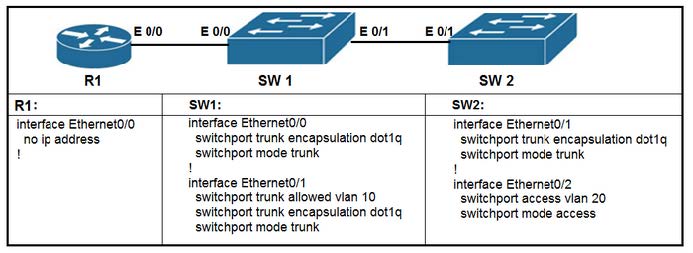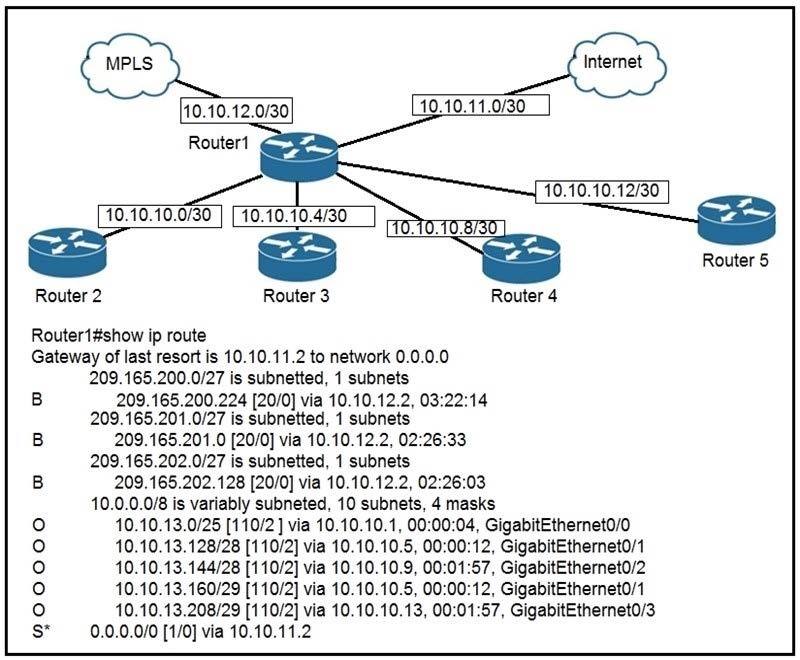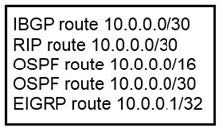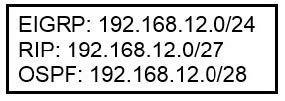Exam Details
Exam Code
:200-301Exam Name
:Implementing and Administering Cisco Solutions (CCNA) (Include Newest Simulation Labs)Certification
:CCNAVendor
:CiscoTotal Questions
:1615 Q&AsLast Updated
:Jun 21, 2025
Cisco CCNA 200-301 Questions & Answers
-
Question 1131:
What are two roles of the Dynamic Host Configuration Protocol (DHCP)? (Choose two.)
A. The DHCP server assigns IP addresses without requiring the client to renew them.
B. The DHCP server leases client IP addresses dynamically.
C. The DHCP client can request up to four DNS server addresses.
D. The DHCP server offers the ability to exclude specific IP addresses from a pool of IP addresses.
E. The DHCP client maintains a pool of IP addresses it can assign.
-
Question 1132:
Which command must be entered when a device is configured as an NTP server?
A. ntp peer
B. ntp master
C. ntp authenticate
D. ntp server
-
Question 1133:
R1 has learned route 10.10.10.0/24 via numerous routing protocols. Which route is installed?
A. route with the next hop that has the highest IP
B. route with the lowest cost
C. route with the lowest administrative distance
D. route with the shortest prefix length
-
Question 1134:
Which two minimum parameters must be configured on an active interface to enable OSPFV2 to operate? (Choose two.)
A. OSPF process ID
B. OSPF MD5 authentication key
C. OSPF stub flag
D. IPv6 address
E. OSPF area
-
Question 1135:
Refer to the exhibit.

What commands are needed to add a subinterface to Ethernet0/0 on R1 to allow for VLAN 20, with IP address 10.20.20.1/24?
A. R1(config)#interface ethernet0/0 R1(config)#encapsulation dot1q 20 R1(config)#ip address 10.20.20.1 255.255.255.0
B. R1(config)#interface ethernet0/0.20 R1(config)#encapsulation dot1q 20 R1(config)#ip address 10.20.20.1 255.255.255.0
C. R1(config)#interface ethernet0/0.20 R1(config)#ip address 10.20.20.1 255.255.255.0
D. R1(config)#interface ethernet0/0 R1(config)#ip address 10.20.20.1 255.255.255.0
-
Question 1136:
Refer to the exhibit.

To which device does Router1 send packets that are destined to host 10.10.13.165?
A. Router2
B. Router3
C. Router4
D. Router5
-
Question 1137:
What are two reasons for an engineer to configure a floating static route? (Choose two.)
A. to enable fallback static routing when the dynamic routing protocol fails
B. to route traffic differently based on the source IP of the packet
C. to automatically route traffic on a secondary path when the primary path goes down
D. to support load balancing via static routing
E. to control the return path of traffic that is sent from the router
-
Question 1138:
Refer to the exhibit.

How does router R1 handle traffic to 192.168.10.16?
A. It selects the IS-IS route because it has the shortest prefix inclusive of the destination address
B. It selects the RIP route because it has the longest prefix inclusive of the destination address
C. It selects the OSPF route because it has the lowest cost
D. It selects the EIGRP route because it has the lowest administrative distance
-
Question 1139:
Refer to the exhibit.

A router received these five routes from different routing information sources. Which two routes does the router install in its routing table? (Choose two)
A. OSPF route 10.0.0.0/30
B. IBGP route 10.0.0.0/30
C. OSPF route 10.0.0.0/16
D. EIGRP route 10.0.0.1/32
E. RIP route 10.0.0.0/30
-
Question 1140:
Refer to the exhibit.

How does the router manage traffic to 192.168.12.16?
A. It chooses the EIGRP route because it has the lowest administrative distance.
B. It load-balances traffic between all three routes.
C. It chooses the OSPF route because it has the longest prefix inclusive of the destination address.
D. It selects the RIP route because it has the longest prefix inclusive of the destination address.
Tips on How to Prepare for the Exams
Nowadays, the certification exams become more and more important and required by more and more enterprises when applying for a job. But how to prepare for the exam effectively? How to prepare for the exam in a short time with less efforts? How to get a ideal result and how to find the most reliable resources? Here on Vcedump.com, you will find all the answers. Vcedump.com provide not only Cisco exam questions, answers and explanations but also complete assistance on your exam preparation and certification application. If you are confused on your 200-301 exam preparations and Cisco certification application, do not hesitate to visit our Vcedump.com to find your solutions here.